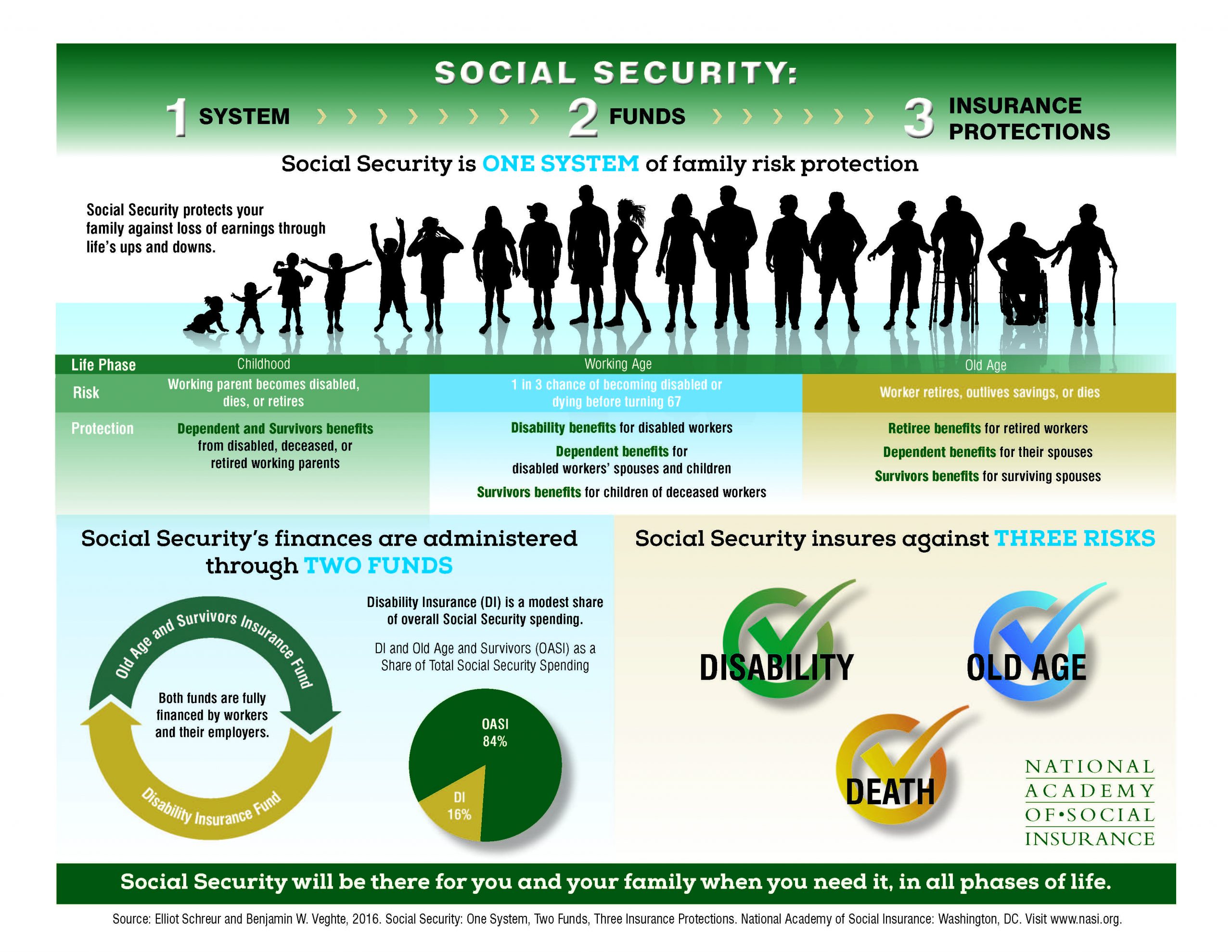4.1 Financial Security System#
Introduction#
Financial security systems are important components of economic frameworks aimed at protecting individuals and organizations from financial risks. These systems are built on several key principles:
Financial Security Systems
Financial security systems encompass various mechanisms and policies implemented by governments, organizations, and individuals to safeguard against financial risks and uncertainties. A financial security system is a way to manage risks where people or organizations can pass on their financial risks and potential losses to another party, called a provider, by making a payment or series of payments.
Example 4.1: Examples of Financial Security Systems
Examples include
insurance schemes (life, health, property),
retirement savings plans (like pensions and provident funds),
unemployment benefits, and
social security programs.
Mandatory vs Voluntary Financial Security System#
Understanding the differences between mandatory and voluntary financial security systems helps clarify how participation is structured and regulated.
Mandatory vs Voluntary Financial Security System
Mandatory Financial Security System: A financial security system where participation is compulsory for all members of a specified group, enforced through regulations or laws.
Voluntary Financial Security System: A financial security system where participation is optional and individuals or entities choose to enroll based on their preferences or needs.

Fig. 19 Source: National Academy of Social Insurance#
Example 4.2: Example Scenarios
Example of a Mandatory Financial Security System: Social security contributions deducted from employees’ salaries in many countries, ensuring income protection during retirement or in case of disability.
Example of a Voluntary Financial Security System: Private health insurance plans that individuals can opt into to cover medical expenses beyond what public healthcare systems provide.
Definition of Risk Measure and Risk Characteristic#
Risk Measure and Risk Characteristic
A risk measure is a function that assigns a numerical value to each risk subject based on a specific quality. It quantifies the level of risk associated with different subjects.
A risk characteristic is a quality that can be measured and quantified by a risk measure. It represents attributes or factors that influence the risk level.
Examples#
Life Insurance: In life insurance, examples of risk characteristics include age, health status, lifestyle habits (like smoking), and occupation. These characteristics are quantified using risk measures to determine the insurance premiums and coverage.
Auto Insurance: In auto insurance, examples of risk characteristics include the driver’s age, driving history, type of vehicle, and location. These factors are measured to assess the risk of accidents and determine insurance premiums.
Health Insurance: In health insurance, examples of risk characteristics include medical history, age, lifestyle choices (such as diet and exercise), and genetic factors. These are measured to evaluate the risk of health issues and to calculate premiums and coverage options.
PRINCIPLE (Risk Classification)#
This principle explains how risk characteristics are used in an actuarial model to group similar risks.
Principle 4.1: Risk Classification#
For a group of risks that can be combined, we can identify certain risk characteristics and measures to create a useful actuarial model. This model works in the following way:
a. Each risk is represented by a set of random variables that describe it.
b. Risks with the same values for the identified risk characteristics are grouped together and represented by the same set of random variables.
Example 4.3: Example in Life Insurance
In life insurance, an actuarial model might use risk characteristics such as age, gender, smoking status, and health condition to classify risks. For instance:
Risk Characteristics: Age (30 years old), Gender (Male), Smoking Status (Non-smoker), Health Condition (Good)
Risk Measures: Numerical values assigned to these characteristics, such as age = 30, smoking status = 0 (for non-smoker)
The actuarial model would then group all 30-year-old non-smoking males in good health together. These individuals would be assigned to the same set of random variables representing their risk level. This grouping helps the insurance company determine premiums and coverage options more accurately for this category of policyholders.
Definition of Risk-Classification System and Risk Class#
Risk-Classification System and Risk Class
A risk-classification system is a method used to categorize risks into groups based on shared characteristics or factors that influence the likelihood of a particular outcome.
A risk class is a specific group within a risk-classification system that shares similar risk characteristics and is treated similarly for insurance purposes.
Example 4.4: Example in Life Insurance
In life insurance, a risk-classification system categorizes policyholders into different risk classes based on factors such as age, health status, lifestyle habits, and occupation. For example:
Risk-Classification System: Groups policyholders based on Age (e.g., 30-39 years old), Health Status (e.g., good health), and Occupation (e.g., office worker).
Risk Classes: Each group represents a different risk class, such as “Young Adults in Good Health” or “Middle-aged Professionals.”
Definition of A Refinement of a Risk-Classification System#
a Risk-Classification System
A refinement of a risk-classification system involves improving the categorization process by adding more detailed or specific criteria to better differentiate between different levels of risk within each class.
PRINCIPLE (Effect of Refinement)#
The principle of the effect of refinement examines how making a risk-classification system more detailed affects how accurately we can estimate financial outcomes related to risks.
Principle 4.2: Effect of Refinement#
When we refine a risk-classification system to categorize risks more precisely, it has two effects on how uncertain our estimates of financial consequences are:
It reduces uncertainty because similar risks are grouped more closely together (increased homogeneity).
It increases uncertainty because there is less data available for each refined risk category.
Principle 4.2 suggests that if we make a risk-classification system too detailed, it might actually decrease the accuracy of our estimates by reducing the amount of data we have for each specific risk category.
Example 4.4: Example Scenario
Original Classification: Policyholders are grouped broadly by age and general health status.
Effect of Refinement: Refining the system to include narrower age ranges and more precise health assessments.
Impact on Estimates: Decreasing the width of the age groups and adding more specific health categories can lead to more accurate estimates of mortality risk for each group. However, it also means there may be fewer policyholders in each refined category, which could increase uncertainty in the estimates due to smaller sample sizes.
In this example, refining the risk-classification system in life insurance by narrowing age groups and adding detailed health categories can improve the accuracy of mortality risk estimates for each group. However, it also highlights the trade-off: more detailed categories may result in smaller sample sizes, potentially increasing uncertainty in the estimates.
Definition of Exposure and Rate Structure#
Exposure and Rate Structure
Exposure in insurance refers to the extent to which an insured item or individual is vulnerable to risk. It represents the potential loss an insurer faces from covering a particular policy or group of policies.
Rate Structure Rate structure in insurance outlines how premiums are calculated based on various factors such as risk, coverage amount, and the insured’s characteristics. It includes the methods used to determine the pricing for insurance policies.
Example 4.5: Example in Life Insurance
In life insurance, exposure could be the total face value of policies held by an insurer, representing the potential liability in case of the insured’s death. The rate structure determines premiums based on factors like age, health, and occupation, reflecting the risk associated with insuring the individual.
PRINCIPLE (Antiselection)#
Principle 4.3: Principle of Antiselection#
Antiselection is the tendency for individuals with higher risk to seek or maintain insurance coverage more than those with lower risk. This can lead to adverse selection, where insurers may face higher-than-expected claims.
Example 4.6: Example in Life Insurance Context
Consider a life insurance policy that does not require medical underwriting. Individuals with serious health issues may be more likely to purchase this policy, anticipating higher benefits for their beneficiaries upon death. This illustrates antiselection because the insurer may end up covering a disproportionately risky group, potentially leading to financial losses if premiums do not adequately reflect the risk.
Definition of Experience#
Experience
Experience in the context of life insurance refers to the insurer’s actual claims and policyholder behavior over a period. It helps insurers assess risks accurately and set premiums accordingly.
Example 4.6: Example in Life Insurance Context
For instance, an insurer analyzes data over five years to determine average claim frequency and amount for policyholders aged 50-60. This experience data informs premium rates for new policies in that demographic.
PRINCIPLE (Moral Hazard)#
In life insurance, the principle of moral hazard suggests that policyholders might engage in riskier activities or be less cautious about their health if they believe the insurance will cover potential losses.
Principle 4.4: Principle of Moral Hazard#
The principle of moral hazard states that individuals may alter their behavior when they are insured, taking on more risk than they otherwise would if they were not covered.
Example 4.6: Example in Life Insurance Context
For example, a policyholder might neglect regular health check-ups or engage in hazardous activities like extreme sports, assuming their life insurance will compensate their beneficiaries adequately if an accident occurs.

Fig. 20 Source: MGR Online#
Definition of Actuarial Soundness#
Actuarial soundness refers to the financial stability and sustainability of an insurance company’s operations, particularly in relation to its ability to accurately predict and set aside reserves for future claims based on statistical and mathematical analysis.
PRINCIPLE (Actuarial Soundness)#
Principle 4.5: Actuarial Soundness#
The principle of actuarial soundness ensures that insurance premiums charged are adequate to cover expected claims and expenses over the long term, thereby maintaining the insurer’s financial health and ability to fulfill its obligations to policyholders.
Example 4.7: Example in Life Insurance Context
For instance, an insurance company calculates premiums for life insurance policies based on actuarial tables that predict average life expectancy, mortality rates, and health risks associated with different demographics. By accurately estimating these factors, the insurer can set premiums at a level that ensures they collect enough funds to pay out claims and cover administrative costs while maintaining profitability.
